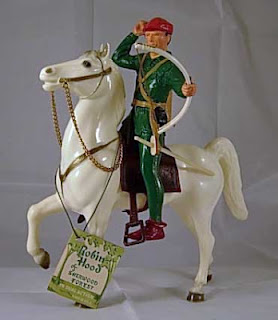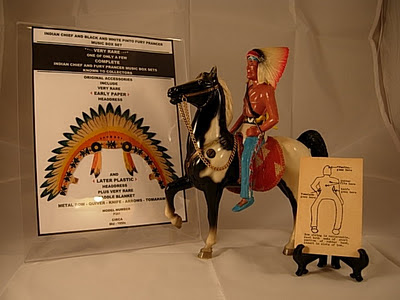"The days are long at Belmont.
Speed they never learn.
And it's many a day since Man O' War
Has looped the upper turn."
Man O' War winning the 1920 Belmont Stakes
Thus begins
Blood-Horse editor Joseph Estes' poem "Big Red" published in the October 23, 1937, issue of that magazine, an homage to the greatest racehorse of all time. The legend of Man O' War has inspired many such tributes in a variety of forms---literature, art, advertising, brand names, and of particular interest to model horse collectors, sculpture.
Man O' War was born on August Belmont's Nursery Stud farm near Lexington, KY, on March 29, 1917. By top runner and sire Fair Play out of the regally bred mare Mahubah, a daughter of the English Triple Crown winner Rock Sand, Man O' War was recognized early on as a quality horse by his breeder. Belmont reluctantly sold the colt, however, after enlisting in the army at the age of 65 to serve in World War I.
Samuel Riddle famously purchased Man O' War for $5,000 at the 1918 Saratoga yearling sale and raced him in his black and gold Glen Riddle Farm colors. As a 2 year-old, Man O' War captured 9 of his 10 starts with his one loss, a fast-closing second, coming though no fault of his own. (He was turned sideways at the start and was intentionally boxed in at the rail by the other jockeys for most of the race.) He carried 130 pounds, an impost usually reserved for older horses (and rarely even then), 6 times while giving away substantial weight to his rivals and beating them easily by open lengths.
At three, he was sublime and utterly untouchable, winning all 11 of his starts, including the Preakness, Belmont, Withers, Dwyer, Travers, Lawrence Realization, Jockey Club Gold Cup, and a match race against the 1919 Triple Crown winner Sir Barton.
If you read the race charts for Man O' War they all conclude with some variation of "eased final furlong" or "in a canter." Despite never being fully extended, he set three world records, two American records, two track records, and equaled another track record. And he didn't just break records by hundredths of seconds; he shattered them. In the Lawrence Realization, he shaved more than 4 seconds off the world record for 1 5/8th miles, winning by an estimated 100 lengths, both unheard of feats. His record for a 1 1/4 miles in the Travers stood for an unprecedented 42 years. No other horse in history can boast such a resume, especially when you take into account the staggering imposts Man O' War carried. In one race, he carried an astonishing 32 pounds more than his rivals. It's no surprise then that his groom Will Harbut called him "de mostest hoss that ever was."
At stud, Man O' War's brilliance continued. He sired numerous champions including Triple Crown winner War Admiral, as well as American Flag (Belmont, Withers, Dwyer), Crusader (Belmont, JCGC, Suburban), Clyde Van Dusen (Kentucky Derby), Scapa Flow (2 year-old champion), Florence Nightingale (Coaching Club American Oaks), Maid At Arms (Alabama), Edith Cavell (CCAO, Pimlico Cup over males twice), and the champion steeplechasers Battleship and Blockade. Man O' Wars daughters, in addition to being top flight runners, proved to be exceptional brood mares as well. He died at the age of 30 on November 1, 1947, and his funeral was broadcast publicly on the radio. He and several of his best offspring were originally interred at Faraway Farm under a larger than life statue by Herbert Haseltine, but in the early 1970s, the graves and statue were moved to their present location at the Kentucky Horse Park.
Man O' War was first immortalized as a collectible work of sculpture by the Grand Wood Carving company of Chicago sometime in the 1940s, probably after the great horse's death. This model is carved from mahogany, and it should look familiar to Breyer collectors.
Photo courtesy of Ed Alcorn / The Hagen-Renaker On-Line Museum Collection
There is some evidence that Breyer sculptor Chris Hess may have worked for the Grand Wood Carving company before being hired by Breyer, but that is the subject for another post. Suffice it say, Breyer had copied the work of GWC before, and their 1967 traditional scale model of Big Red was most definitely influenced by the GWC piece, right down to the halter. This is one of the earliest variations of the #47 Man O' War with eye-whites and distinctive battleship grey hooves.
Photo courtesy of Kristen Arendt
GWC produced a number of famous racehorses, many of which came on wood bases with name plaques. The idea for the Breyer Presentation Collection may have come from that practice. The Presentation Man O' War is the rarest of the traditional MOWs, made from 1971-1973 only.
The trad MOW was produced from 1967-1995, and not surprisingly, his color varied a bit over the years. The models from the late 1980s into the 1990s have, in my opinion, always best exemplified the "look" of Big Red. They tend to be a vibrant rich red chestnut with little shading.
Photo courtesy of Kristen Arendt
In 1990, Sears offered a very popular set of three glossy racehorses including Man O'War. Only 2000 pieces were made.
Photo courtesy of Penny Lehew, co-author of the Breyer Animal Quick Reference
In spring of 1961, Hagen-Renaker released their Designers Workshop Man O' War sculpted by Maureen Love. Of all of the MOW portraits, hers was the truest to the physique and majesty of the real horse as the photo below will attest. The HR MOW was in production from Spring 1961-Spring 1971 and from Fall 1974-Fall 1975, so he's not an especially rare piece. He is particularly lovely, however, and a must have for all MOW fans.
Monrovia and San Dimas versions, photo courtesy of Ed Alcorn / The Hagen-Renaker On-Line Museum Collection
A photo of Man O' War as a young stallion. I believe this may have been the photo that inspired Maureen Love's sculpture.
Photo courtesy of Thoroughbred Heritage
In 1975, Breyer arranged a lease for plastic production rights of Hagen-Renaker's DW Thoroughbred models, including Man O' War. The #602 Classic Man O' War model ran until 1990. Like his traditional counterpart, he ranged in color from more golden chestnut to deep red chestnut. His face marking also varied. The earliest models have a broken stripe like the model on the left, and the later ones had a star like the model on the right. The star-faced model first appears in the 1988 catalog.
In the late 1980s, American Artists released a series of resin racehorses. Fred Stone sculpted Man O' War for them, and the pose of this model bears a striking resemblance to Fred's
famous painting of the horse. I believe 2500 pieces were made.
Photo courtesy of Karen Grimm / The Black Horse Ranch Collection
In 2004, the most recent Man O' War model was produced by Starlite Originals, sculpted by Kitty Cantrell. It was limited to 2500 pieces.
Photo courtesy of Karen Grimm / The Black Horse Ranch Collection
As you may have guessed, I have been a lifelong, die-hard fan of Man O' War. One of my earliest memories is of my dad reading C.W. Anderson horse books to me, and MOW was, rightfully so, the benchmark by which Anderson measured all other horses. So it's only fitting that I painted by my own Man O' War on Carol Williams' incredible
Valor resin. While Valor is a mega-popular model, I don't think my guy is exactly collectible other than to me, but how could I not include him?
"We watch the heroes parading,
We wait, and our eyes are dim,
But we never discover another
Like him."
(Estes' entire poem can be found here.)








































